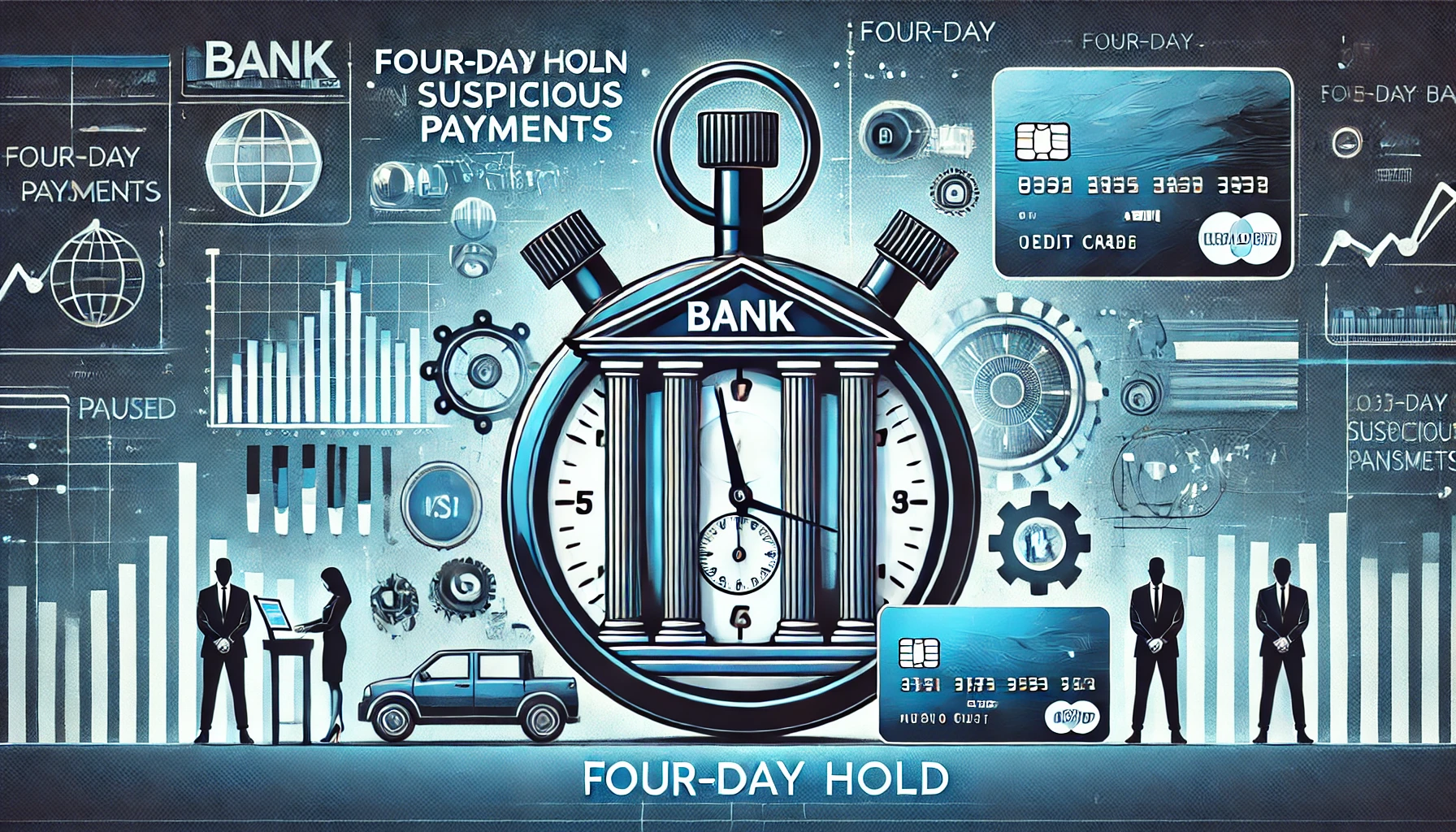Why Banks Are Implementing a Four-Day Hold on Suspicious Payments: What You Need to Know
- Posted by James Wilson (America)
- Categories Business
- Date October 3, 2024
With the rise in bank payment fraud and ever-evolving cyber threats, banks are enhancing their fraud detection systems. One recent change is the decision to implement a four-day hold on suspicious payments, giving financial institutions more time to investigate questionable transactions before clearing them. While this may seem like a hassle for some, these measures are designed to protect customers from fraud and prevent fraudulent transactions from going through.
In this blog, we’ll explain how suspicious payments hold policies work, what triggers a fraudulent payment review, and how banks are leveraging these holds to prevent financial crime. We’ll also explore the importance of Suspicious Activity Reports (SARs) and the broader fraud prevention bank hold strategies that help keep your money safe.
What Is a Suspicious Payments Hold?
A suspicious payments hold is a temporary delay banks place on a payment or transaction they believe may involve fraudulent activity. This four-day payment hold allows the bank time to investigate and verify the legitimacy of the payment. Such holds can be triggered by a range of factors, from unusual transaction amounts to abnormal spending patterns.
Why Four Days?
The four-day payment hold period is a standard length that gives banks adequate time to investigate the suspicious transaction and initiate any necessary fraudulent payment reviews. During this time, the bank will examine the payment for any red flags that may indicate bank payment fraud, such as unauthorized access to your account or out-of-pattern purchases. If the bank determines that the payment is legitimate, it will be cleared; otherwise, further actions will be taken to prevent fraud.
While a fraudulent transaction delay may cause inconvenience, the additional security it offers to consumers is invaluable. By pausing the transaction, banks reduce the risk of fraudulent payments being processed, which could lead to lost funds and subsequent legal complications.
What Triggers a Bank to Put a Hold on Suspicious Payments?
Several triggers can lead to a suspicious payments hold, each designed to detect potential fraud as early as possible. Banks use sophisticated software and algorithms to flag suspicious activity, and these triggers may include:
- Large or Unusual Transactions: A sudden large transaction that doesn’t fit your usual spending pattern could lead to a hold. For instance, if your account normally sees small, recurring purchases and suddenly a high-value transaction appears, the bank may suspect bank payment fraud.
- Geographic Location: Payments made from different geographic locations within a short timeframe may trigger a hold. For example, if you make a purchase in New York and then another transaction appears from a different country just hours later, this inconsistency could prompt a review.
- Multiple Attempts: Repeated attempts to make a payment with insufficient funds, incorrect login credentials, or other suspicious behavior could lead the bank to put the payment on hold for further investigation.
The Role of Fraud Detection Algorithms
Banks rely on highly sophisticated algorithms to detect fraudulent payment attempts. These algorithms scan millions of transactions in real time, looking for unusual patterns or known signs of fraud. When the system detects something that doesn’t align with normal account activity, it can trigger a fraudulent payment review and put a temporary hold on the transaction.
How Does a Fraudulent Payment Review Work?
Once a transaction has been flagged as suspicious, the bank initiates a fraudulent payment review. During this process, the bank examines various factors related to the transaction, such as the source of the payment, the destination, and the overall account history. In some cases, the bank may contact the account holder to verify the legitimacy of the payment.
Communication with the Account Holder
If your payment is flagged for a fraudulent payment review, the bank will typically notify you and request further information. This could be in the form of a phone call, email, or a message through your online banking portal. The bank may ask you to confirm whether you authorized the transaction or request additional documentation if needed.
During this period, the bank holds the payment to prevent it from being processed. If the transaction is confirmed as legitimate, the payment will be processed after the hold period. However, if the payment is deemed suspicious, the bank will take further steps, such as blocking the payment and potentially filing a Suspicious Activity Report (SAR) with the appropriate authorities.
What Are Suspicious Activity Reports (SARs)?
A Suspicious Activity Report (SAR) is a document that financial institutions are required to file with regulators when they detect potentially fraudulent or illegal activity. Banks file SARs when they believe a transaction could be linked to criminal activities such as money laundering, terrorism financing, or fraud.
Why Are SARs Important?
SARs play a crucial role in identifying and preventing financial crimes. By filing these reports, banks help law enforcement track illegal activities, uncover criminal networks, and safeguard the financial system from misuse. Filing a Suspicious Activity Report (SAR) is a legal obligation for banks under federal regulations, and failure to report suspicious activity can lead to fines or sanctions.
SARs are kept confidential, and the person or entity involved in the suspicious activity is not notified when a report is filed. This helps protect the integrity of the investigation while law enforcement agencies conduct further inquiries.
How Do Banks Handle Fraud Prevention and Suspicious Payments Holds?
As part of a broader payment fraud prevention strategy, banks employ a combination of technology, risk management policies, and regulatory compliance to address bank fraud investigation concerns. Fraud prevention bank hold procedures, including four-day payment holds, serve as essential tools in identifying and stopping fraudulent transactions before they can harm customers.
Fraud Prevention Strategies
- Real-Time Monitoring: Banks monitor transactions around the clock, using sophisticated systems to detect fraudulent activities as they occur.
- Advanced Authentication: Many banks now employ multi-factor authentication (MFA) to prevent unauthorized access to accounts. MFA requires users to provide additional verification, such as a text code or biometric data, making it harder for fraudsters to gain access.
- Collaborating with Law Enforcement: Banks work closely with law enforcement agencies to address larger fraud schemes and organized crime rings. Filing Suspicious Activity Reports (SARs) is a critical part of this collaboration.
How Banks Use Holds to Protect You from Fraud
While a four-day payment hold on suspicious payments may seem inconvenient, it is a crucial part of fraud prevention measures designed to protect customers. By taking the time to investigate potentially fraudulent transactions, banks can stop criminal activities in their tracks, preventing significant financial losses for both consumers and institutions. These holds are triggered by algorithms and risk assessments that aim to detect bank payment fraud, ensuring the safety of your money.
Understanding how these holds work and why they are necessary can help consumers appreciate the importance of financial security measures. By being proactive about your transactions and promptly responding to any inquiries from your bank, you can further protect your accounts from fraud.
For more insights on how banks protect your money, visit Regent Studies. To learn more about the broader strategies used to combat financial fraud, check out this comprehensive guide on payment fraud prevention from J.P. Morgan(J.P. Morgan | Official Website).
Previous post
How Humana’s Medicare Advantage Star Ratings Cut Threatens Revenue and Customer Trust
Next post



